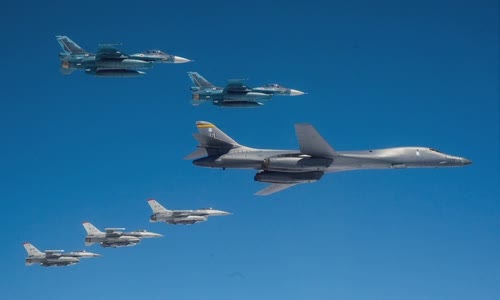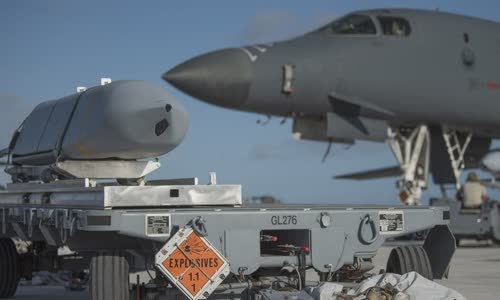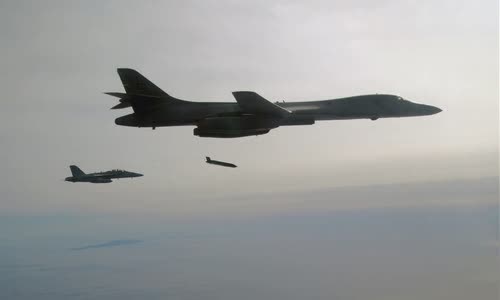B-1B aircraft are constantly present in Asia - Pacific, demonstrating the ability to deploy US power in competitive relations with China.
After the withdrawal of all B-52 bombers from Guam and the end of the Continuous Bomber Presence (CBP) mission there on April 17, the United States led many allies and partners in Asia-Pacific.

The B-1B was rehearsing with the American F-16 and Japanese F-2 fighters on April 22 Photo: USAF
US Air Force in the Pacific (PACAF) said B-1B squadron will carry out training missions and "strategic deterrence missions" in the Indo-Pacific.
Not only carrying out flights lasting dozens of hours to different areas, B-1B aircraft are resuming training with high-precision long-range assault weapons in Thai Binh Duong, the
"The great thing about the B-1B line is that they can carry Long Range Anti-Ship Missiles (LRASM), the perfect weapon for the Pacific front," said General Jim Dawkins Jr., commander of the Joint Coordination Center.
"We not only re-adjusted the ratio of aircraft ready for missions and training activities, but also changed the way we deploy to lead to the competition between powers according to the National Defense Strategy (
Availability ratio indicates the number of aircraft that can depart at a given time.
The NDS document, published by the US government in 2018, sees China as a "strategic competitor specializing in economic power to threaten neighbors and militarize entities in the South China Sea."
The Pentagon's strategy is to deter opponents by stopping them from deploying military power.

JASSM rocket is about to be installed on B-1B aircraft in Guam on 8/5 Photo: USAF
"In a simulated attack, the crew will select the drone, plan and constantly fly in an area that would threaten that target without fear of retaliation. Long-range missile launch like JASSM-
US commanders did not disclose details of the rehearsals of the Lancers in the Pacific, but the squadron recently began carrying the JASSM stealth cruise missile, one of the long-range air-to-ground weapons.
AGM-158 JASSM is a long-range cruise missile launched by Lockheed Martin for the US Air Force.
The weapon first entered combat on April 14, 2018, when 19 AGM-158B JASSM-ER tanks were fired from the B-1B Lancer bomber aimed at targets in Syria.
The AGM-158C LRASM, meanwhile, is an anti-ship missile developed from the JASSM platform to create an AGM-84 Harpoon anti-ship missile.
LRASM rockets are equipped with a multifunctional radio probe and an advanced datalink.
Each B-1B bomber can carry up to 57 tons of weapons, double the B-52 or B-2 Spirit, allowing them to carry up to 24 JASSM-ER or LRASM in a mission.

B-1B bomber launches LRASM missile at the end of 2017 Photo: US Navy
The vast area of the Pacific Ocean is suitable for training missions using long-range missiles, which is difficult to perform when the B-1B drills on the US coast.
A B-1B in late April made a 30-hour flight from South Dakota to Japan and back to the United States.
"The B-1B squadron could become America's representative face in the Pacific in the near future," Dawkins said, adding that current missions would pave the way for efforts to integrate supersonic missiles.
The United States Air Force's Global Offensive Command (AFGSC) last year introduced an upgrade package for the B-1B series, allowing them to bring up to 40 missiles and bombs of all kinds, as well as weapons with masses.
AFGSC affirms that this solution is based on the existing design of the B-1B series, does not require body frame modification and ensures compliance with the New Strategic Arms Reduction Treaty (New START).
"We are pursuing an over-the-air weapon solution, allowing each B-1B to carry 6 Quick-Release Weapon-response (ARRW) bullets, while LRASM and JASSM-ER missiles remain



 Mirza Lipi
Mirza Lipi







